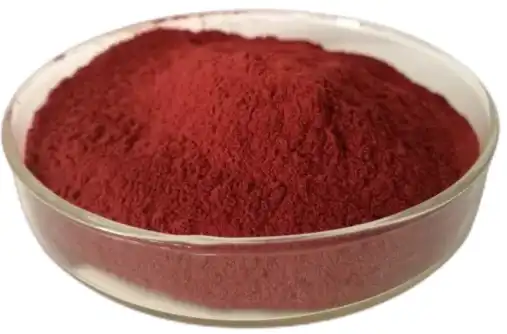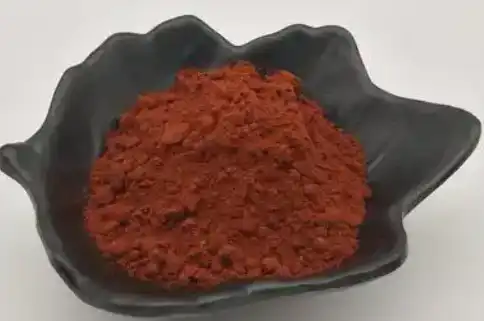How Is Astaxanthin Powder Produced Industrially?
Astaxanthin, a powerful antioxidant and vibrant red pigment, has gained significant attention in the health and nutrition industry. As demand for this remarkable compound grows, understanding its industrial production process becomes increasingly important. In this comprehensive guide, we'll explore the various methods used to produce Astaxanthin Powder on a large scale, including microbial fermentation, algae cultivation, and advanced processing techniques.
Is microbial fermentation used to produce Astaxanthin Powder?
Microbial fermentation is indeed one of the primary methods employed in the industrial production of Astaxanthin Powder. This process leverages the power of microorganisms to synthesize astaxanthin in controlled environments, offering several advantages over traditional extraction methods.
The microbial fermentation approach typically involves the use of specific yeast strains, such as Phaffia rhodozyma (also known as Xanthophyllomyces dendrorhous). These microorganisms have been genetically optimized to produce high levels of astaxanthin under carefully controlled conditions.
The fermentation process unfolds in several stages:
- Inoculation: Selected yeast strains are introduced into a nutrient-rich medium.
- Growth phase: The microorganisms multiply rapidly, consuming the provided nutrients.
- Induction: Specific environmental stresses are applied to trigger astaxanthin production.
- Harvesting: The astaxanthin-rich biomass is separated from the fermentation broth.
- Extraction: Various methods are used to isolate the astaxanthin from the microbial cells.
- Purification: The extracted astaxanthin undergoes further refinement to meet quality standards.
Microbial fermentation offers several benefits for Astaxanthin Powder production:
- Scalability: Fermentation can be easily scaled up to meet increasing demand.
- Consistency: Controlled conditions ensure uniform product quality.
- Sustainability: This method requires fewer resources compared to traditional algae cultivation.
- Year-round production: Indoor fermentation is not subject to seasonal limitations.
However, it's worth noting that the astaxanthin produced through microbial fermentation is often considered "nature-identical" rather than truly natural, which may be a consideration for some consumers and applications.
Algae vs. yeast vs. bacterial production methods
While microbial fermentation using yeast is a popular method for producing Astaxanthin Powder, it's not the only approach. Let's compare the three main biological production methods: algae cultivation, yeast fermentation, and bacterial synthesis.
Algae Cultivation
Algae, particularly the species Haematococcus pluvialis, are the primary natural source of astaxanthin. The industrial production process involves:
- Cultivation: Algae are grown in photobioreactors or open ponds under controlled conditions.
- Stress induction: Environmental stressors like high light intensity or nutrient deprivation trigger astaxanthin production.
- Harvesting: The astaxanthin-rich algae are collected and processed.
- Extraction: Various methods, including supercritical CO2 extraction, are used to isolate the astaxanthin.
Advantages of algal production:
- Natural source: Considered the most "natural" form of astaxanthin.
- High purity: Can achieve up to 95% pure astaxanthin.
- Established market acceptance: Widely recognized and preferred by many consumers.
Challenges:
- Resource-intensive: Requires significant land, water, and energy inputs.
- Weather-dependent: Outdoor cultivation can be affected by climate conditions.
- Slower growth: Algae typically have longer production cycles compared to microorganisms.
Yeast Fermentation
As discussed earlier, yeast fermentation, particularly using Phaffia rhodozyma, is a popular industrial method for producing astaxanthin.
Advantages of yeast production:
- Rapid growth: Yeast multiply quickly, allowing for faster production cycles.
- Controlled environment: Indoor fermentation enables year-round production.
- Scalability: Easily adaptable to meet varying demand levels.
Challenges:
- Lower concentration: Yeast typically produce lower astaxanthin concentrations compared to algae.
- Perception: Some consumers may prefer "natural" algal sources over yeast-derived astaxanthin.
Bacterial Synthesis
While less common, certain bacteria, such as genetically modified Escherichia coli strains, can also be used to produce astaxanthin.
Advantages of bacterial production:
- Rapid growth: Bacteria have the fastest replication rates among the three methods.
- Genetic flexibility: Easier to modify for enhanced astaxanthin production.
- Low resource requirements: Can grow on simple, inexpensive media.
Challenges:
- Regulatory hurdles: Use of genetically modified organisms may face regulatory challenges in some markets.
- Consumer acceptance: May be perceived as the least "natural" production method.
- Purification complexity: Separating astaxanthin from bacterial biomass can be more challenging.
Each of these methods has its own set of advantages and challenges. The choice of production method often depends on factors such as target market, regulatory environment, production scale, and desired product characteristics. Many industrial producers may employ a combination of these methods to meet diverse market demands and ensure a stable supply of Astaxanthin Powder.
Microencapsulation and spray‑drying for powdered forms
Once astaxanthin has been produced and extracted, regardless of the method used, it must be processed into a stable, powdered form for many applications. This is where advanced techniques like microencapsulation and spray-drying come into play, transforming the raw astaxanthin into the final Astaxanthin Powder product.
Microencapsulation
Microencapsulation is a crucial step in the production of high-quality Astaxanthin Powder. This process involves enveloping microscopic particles of astaxanthin within a protective coating or matrix. The benefits of microencapsulation include:
- Enhanced stability: Protects astaxanthin from oxidation, light, and temperature fluctuations.
- Improved solubility: Can make the astaxanthin more dispersible in various formulations.
- Controlled release: Allows for better bioavailability and absorption in the body.
- Masking of taste: Helps to neutralize any undesirable flavors or odors.
Common microencapsulation techniques for astaxanthin include:
- Emulsion-based methods: Creating oil-in-water or water-in-oil emulsions before further processing.
- Coacervation: Forming a coating around astaxanthin droplets through phase separation of a polymer solution.
- Liposomal encapsulation: Enveloping astaxanthin within lipid bilayers to form liposomes.
The choice of encapsulation material is crucial and may include natural polymers (like maltodextrin or gum arabic), proteins (such as whey or soy protein), or synthetic materials, depending on the desired properties and applications of the final product.
Spray-Drying
Spray-drying is a widely used industrial process for converting liquid formulations into dry powder form. For Astaxanthin Powder production, it often follows the microencapsulation step. The spray-drying process typically involves:
- Preparation: The microencapsulated astaxanthin solution or suspension is prepared.
- Atomization: The liquid is sprayed into a fine mist inside a drying chamber.
- Drying: Hot air is introduced, rapidly evaporating the liquid and leaving behind solid particles.
- Separation: The dried powder is separated from the air stream, often using cyclones or bag filters.
- Collection: The final Astaxanthin Powder is collected and packaged.
Advantages of spray-drying for Astaxanthin Powder production:
- Rapid processing: Conversion from liquid to powder occurs almost instantaneously.
- Particle size control: The atomization process allows for precise control over particle size distribution.
- Scalability: Spray-drying can be easily scaled up for industrial production volumes.

- Continuous operation: The process can run continuously, improving efficiency.
Challenges and considerations:
- Heat sensitivity: Care must be taken to minimize thermal degradation of astaxanthin during drying.
- Yield optimization: Process parameters must be carefully controlled to maximize powder yield and quality.
- Equipment investment: Industrial-scale spray-dryers represent a significant capital investment.
The combination of microencapsulation and spray-drying allows for the production of high-quality Astaxanthin Powder with enhanced stability, improved handling properties, and versatility for various applications in the nutraceutical, food, and cosmetic industries.
Conclusion
The industrial production of Astaxanthin Powder is a complex process that combines cutting-edge biotechnology with advanced processing techniques. From the initial cultivation or fermentation of astaxanthin-producing organisms to the final steps of microencapsulation and spray-drying, each stage plays a crucial role in creating a high-quality, stable product.
As research continues and technologies evolve, we can expect to see further innovations in Astaxanthin Powder production, potentially leading to more efficient, sustainable, and cost-effective methods. These advancements will help meet the growing global demand for this powerful antioxidant, opening up new possibilities in health, nutrition, and beyond.
If you're looking for a reliable source of high-quality Astaxanthin Powder for your products, look no further than Angelbio. As a leading innovator in natural ingredients for the health and wellness industry, we combine cutting-edge technology with stringent quality control to deliver superior astaxanthin products. Our team of experts is dedicated to providing tailored solutions that meet your specific needs, whether you're in the nutritional supplement, cosmetics, or functional food sectors. Experience the Angelbio difference and elevate your products with our premium Astaxanthin Powder. Contact us today at angel@angelbiology.com to learn more about how we can support your business goals.
References
1. Johnson, E. A., & Schroeder, W. A. (1995). Microbial carotenoids. Advances in biochemical engineering/biotechnology, 53, 119-178.
2. Lorenz, R. T., & Cysewski, G. R. (2000). Commercial potential for Haematococcus microalgae as a natural source of astaxanthin. Trends in biotechnology, 18(4), 160-167.
3. Higuera-Ciapara, I., Felix-Valenzuela, L., & Goycoolea, F. M. (2006). Astaxanthin: a review of its chemistry and applications. Critical reviews in food science and nutrition, 46(2), 185-196.
4. Shah, M. M. R., Liang, Y., Cheng, J. J., & Daroch, M. (2016). Astaxanthin-producing green microalga Haematococcus pluvialis: from single cell to high value commercial products. Frontiers in plant science, 7, 531.


